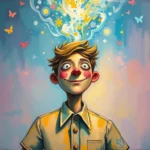
Have you ever woken up from a dream feeling that a message was buried within its vibrant tapestry? Dreams are the mind’s whimsical playground, a space where our conscious thoughts intertwine with our deep-seated fears, desires, and memories. They can be a source of inspiration, confusion, or even revelation. As you navigate the intricate pathways of your dreams, you may find that they hold the keys to understanding your waking life. So, let’s embark on a journey together—one that will help you decode the symbols and experiences that shape your dreams and, ultimately, your life.
In this exploration, we’ll uncover how dreams serve as mirrors reflecting our innermost selves. We’ll delve into the art of symbol analysis, dissect various dream scenarios, and reflect on the potential for personal growth that lies within each dream. By the end of this article, you’ll be equipped with insights to help you interpret your own dreams and use them as a guide through life’s labyrinth.
Dream Symbols: The Language of the Unconscious
Dreams often communicate through symbols, each carrying a weight of meaning that can vary across cultures and personal experiences. These symbols can act as portals to your subconscious, revealing truths you may not fully grasp in the waking world.
Imagine a dream where you find yourself in a maze. This symbol can represent feelings of confusion or being trapped in your current life situation. Alternatively, a maze might symbolize the journey of self-discovery, suggesting that navigating through the complexities of life can lead you to profound insights.
In different cultures, common dream symbols can take on unique meanings. For example, in Native American cultures, the owl symbolizes wisdom and intuition, while in Asian cultures, the dragon often represents power and strength. Understanding the cultural significance of symbols can enrich your interpretation and provide a broader perspective on your dreams.
Another common symbol is water. Water can represent emotions—calm, turbulent, stagnant, or flowing. Dreaming of a calm lake may suggest peace and clarity in your emotional state, whereas a raging storm could indicate turmoil or unresolved issues. Paying attention to the state of the water in your dreams can guide you in understanding your emotional landscape.
Additionally, flying in dreams is often associated with a longing for freedom and escape. It can symbolize the desire to rise above challenges and embrace new perspectives. Conversely, if you find yourself falling, it may represent anxiety or fear of losing control in your life.
By unpacking these symbols, you can begin to see the threads connecting your dreams to your waking life, creating a tapestry that reveals your inner thoughts and feelings.
Dreamscapes: Tales of the Mind’s Theater
Now that we’ve explored the symbols, let’s dive into specific dream scenarios that many of us encounter. Each of these situations can offer valuable insights into our lives and emotions.
1. The Endless Chase
Imagine dreaming you are being chased through shadowy streets. This chase often reflects feelings of anxiety or avoidance in your waking life. You might be running from a situation or an emotion that you find difficult to confront. Consider what or who is pursuing you; this can provide clues about what you are trying to escape. Are you avoiding a difficult conversation? Is there a responsibility you’re shying away from?
2. The Falling Experience
In another common dream, you find yourself falling from a great height. This feeling of free-fall can signify a lack of control or insecurity in your life. Perhaps you’re facing a decision that feels overwhelming, or you fear failure in a new venture. Reflect on what aspects of your life feel unstable, and consider how you can ground yourself.
3. The Lost in a Crowd
Picture yourself lost in a bustling crowd, unable to find a familiar face. This scenario often represents feelings of isolation or a fear of being overlooked. It can also highlight feelings of being lost in your identity or purpose. Ask yourself when you last felt truly connected to others and explore ways to rekindle those connections.
4. The Recurring Test
What about dreams where you’re unprepared for an exam or a performance? This kind of dream can reflect feelings of inadequacy or self-doubt. You may feel unprepared for challenges in your life, whether in your career, relationships, or personal goals. Consider the areas in your life where you feel unready, and think about what support or preparation you might need.
5. The Journey Home
Lastly, envision a dream where you are on a quest to return home, encountering obstacles along the way. This can symbolize a search for belonging or a desire to reconnect with your roots. It might also signify a journey of self-discovery, as you navigate life’s challenges. Reflect on what “home” means to you—is it a physical place, a state of mind, or a sense of community?
By analyzing these common scenarios, you can uncover patterns in your dreams that resonate with your daily life. Each dream serves as a gentle nudge, inviting you to explore feelings, fears, and desires that may otherwise go unexamined.
The Path of Transformation: Embracing Personal Growth
As we draw our exploration to a close, it’s essential to focus on how to use your dream insights for personal growth. Understanding your dreams is not just about deciphering their meanings; it’s about embracing their lessons and allowing them to guide you toward a more fulfilling life.
1. Keep a Dream Journal
Start by keeping a dream journal. Every morning, jot down your dreams as soon as you wake up. Record the symbols, emotions, and any significant details. Over time, you’ll begin to notice patterns and themes that recur, offering you deeper insights into your subconscious.
2. Reflect on Emotions
Don’t shy away from the emotions that surface during your dreams. Take time to reflect on these feelings. If a dream brings up fear, excitement, or sadness, explore those feelings in your waking life. What do they reveal about your current situation? How can you address these emotions constructively?
3. Set Intentions
After analyzing your dreams, set intentions based on your insights. If you find recurring themes of anxiety, perhaps you can establish small, actionable steps to confront what’s causing that anxiety. If a dream about flying inspires a desire for freedom, consider how you can incorporate more joy and spontaneity into your life.
4. Seek Guidance
If you feel stuck in interpreting your dreams, consider seeking guidance from a therapist or a dream analyst. They can provide additional perspectives and support you in navigating the complexities of your subconscious.
5. Embrace the Journey
Finally, remember that understanding your dreams is a journey, not a destination. Be patient with yourself as you explore the meanings and messages within your dreams. Each dream is a stepping stone on your path to self-awareness and growth.
As you embrace this journey, reflect on this powerful thought: “In the labyrinth of dreams, each turn, each shadow, and each symbol brings us closer to our true selves.” Allow your dreams to be your compass, guiding you through the maze of life with newfound clarity and purpose.
By understanding the language of your dreams, you can unlock doors to self-discovery and navigate your life’s path with greater confidence and insight. So, go ahead—dive deep into your subconscious, unravel the symbols, and let your dreams illuminate your way through life’s beautiful complexity.







